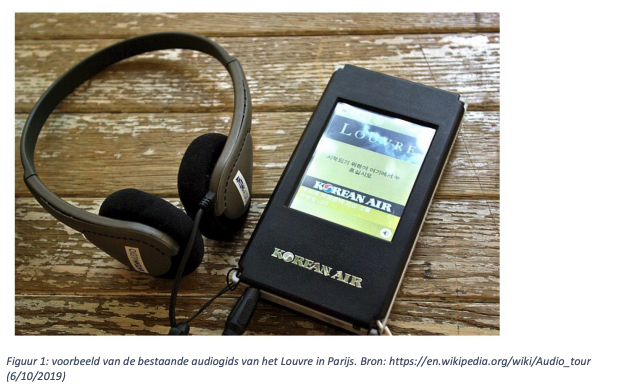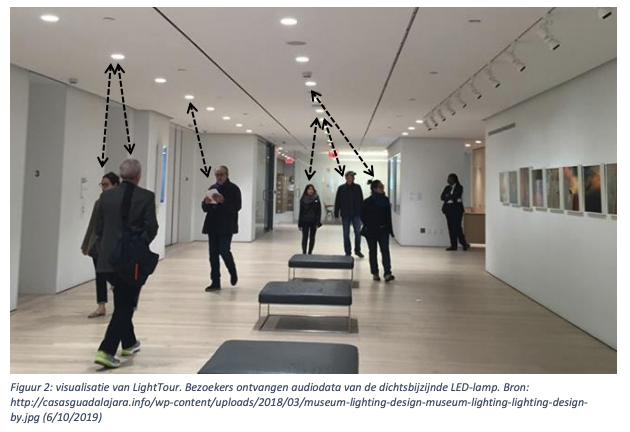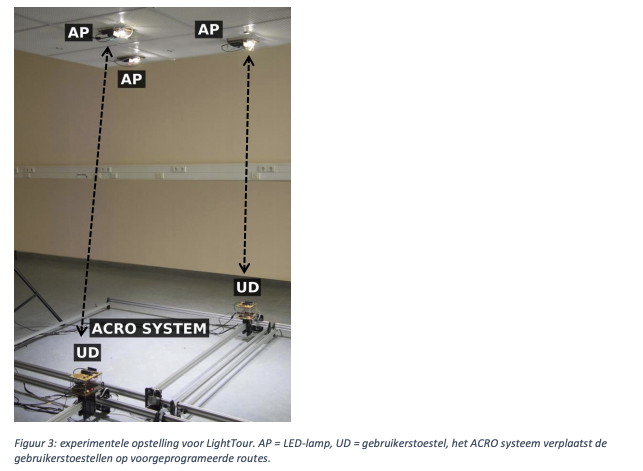Bezoek het museum en laat je leiden door de licht.
Je kent hem wel, audiogids, het draagbare apparaatje dat bezoekers met geluidsfragmenten doorheen een museum leidt. Het apparaatje is licht en makkelijk te bedienen. De geluidsfragmenten staan in het geheugen. Via knoppen of een touchscreen selecteren de bezoekers zelf het fragment dat ze willen beluisteren.
Hoe revolutionair het systeem enkele decennia geleden ook was, tegenwoordig moeten we toch beter kunnen. Daarom ging ik op zoek gaan naar een moderne manier om een museumbezoek boeiender te maken. Kan je bijvoorbeeld gebruik maken van de verlichting van het museumgebouw om geluidsfragmenten te versturen?
Ja, dat kan met een nieuw systeem dat we LightTour doopten. LightTour maakt het mogelijk om audiodata naar bezoekers te versturen met behulp van LED-lampen. Het is zelfs gebruiksvriendelijker, efficiënter en interactiever dan de bestaande audiogidsen.
De verlichting is je gids
In elk museum is er verlichting. Op een ingenieuze manier maakt LightTour gebruik van die verlichting om geluidsfragmenten draadloos te versturen. Als bezoeker krijg je nog steeds een klein toestel mee. Maar dat toestel is nu uitgerust een lichtsensor. Die lichtsensor vangt lichtsignalen op die uitgezonden worden door LED-lampen en zet ze om in geluid.
Licht gebruiken om data zoals geluidsfragmenten te transporteren wordt Visible Light Communication (VLC), of ook wel Li-Fi, genoemd. VLC is een recente vorm van draadloze communicatie waarbij je geen radio-antennes maar LED-lampen gebruikt om data te uit te zenden. Dit gebeurt door een lamp bliksemsnel aan- en uit te schakelen. Zo snel dat het menselijk oog het geflikker niet meer waarneemt. Voor een mens lijkt de lamp normaal te branden. Het voordeel is dat de lamp die de audiodata uitzendt tegelijk ook de ruimte verlicht.
Bij LightTour zijn de LED-lampen in een rasterpatroon aan het plafond bevestigd. Welke geluidsfragmenten verstuurd worden door een lamp hangt af van haar positie. Zo zal een lamp dichtbij een bepaald museumstuk enkel geluidsfragmenten over dat stuk uitzenden. Je toestel zal automatisch het juiste audiofragment afspelen wanneer je in de buurt van een museumstuk komt.
Waarom zou je LED-lampen gebruiken om audiodata te versturen? Maak je niet beter gebruik van radiogolven met bijvoorbeeld Wi-Fi of bluetooth? Nee, toch niet, want Visible Light Communication heeft enkele belangrijke voordelen. Bij VLC ligt het energieverbruik aanzienlijk lager. Met het lichtsignaal kan je immers zowel de ruimte verlichten als de data transporteren. Bovendien is bij VLC de hardware van elke zender en ontvanger veel eenvoudiger. Dat maakt het systeem goedkoper.
Data in twee richtingen maken een museumbezoek interactiever
Met LightTour kan je een bezoek aan een museum ook interactiever maken. Hiervoor moet de bezoeker niet alleen data kunnen ontvangen maar ook uitzenden. In mijn thesis werk ik het voorbeeld uit van een eenvoudige interactieve applicatie waarmee de bezoeker een stukje tekst kan uploaden. Als de bezoeker zijn mening over een museumstuk in zijn toestel typt, worden de tekstdata omgezet in een infraroodsignaal. Iedere LED-lamp aan het plafond bevat een lichtsensor die dit infraroodsignaal opvangt. Op die manier krijgt het museum dus onmiddellijk feedback van de bezoekers.
Nieuwe communicatieprotocols bestand tegen de drukte
Wat gebeurt er als er een groot aantal bezoekers in het museum rondlopen? Kan het systeem zoveel signalen tegelijk aan? Als er veel bezoekers via dezelfde lamp een audiofragment willen ontvangen of een stukje tekst willen uploaden, kan het systeem overbelast raken.
Een bijkomende uitdaging is het probleem van de interferentie. Interferentie doet zich voor als een bezoeker zich tussen twee naburige lampen bevindt die allebei tegelijk data uitzenden. Je kan dit vergelijken met de interferentie die je ondervindt als meerdere radiozenders op dezelfde golflengte uitzenden. Data kunnen enkel correct worden ontvangen als maar één van de naburige lampen tegelijk uitzendt.
Om deze problemen op te lossen zou je simpelweg de datasnelheid van elke lamp kunnen verhogen. Maar dat is een naïeve oplossing. De LED-module in elke lamp moet dan immers uitgerust worden met complexere elektronica en een snellere processor. Zoiets kost al gauw enkele euro’s per lamp. In een groot museum, zoals het Louvre, waar meer dan 10,000 lampen nodig zijn, betekent dat een aanzienlijke meerprijs.
Om het systeem commercieel aantrekkelijk te maken, moet je het probleem van overbelasting en interferentie dus op een goedkopere manier opvangen. Gelukkig bieden de nieuwe communicatieprotocols hier mogelijkheden. Communicatieprotocols bepalen op welk moment welke LED-lamp en welk bezoekerstoestel data mogen versturen. Voor LightTour heb ik nieuwe protocols ontwerpen die erin slagen het probleem met goedkope elektronica op te lossen.
De nieuwe protocols zijn gebaseerd op drie eenvoudige principes:
Ten eerste is er het principe van het ‘broadcasten’. Dit zorgt ervoor dat elke LED-lamp audiodata naar meerdere bezoekers tegelijk kan sturen. Het voordeel is dat dezelfde audiodata niet voortdurend naar elke bezoeker apart moeten verzonden worden. Tijdens grote drukte kan iedereen dan tegelijk audiofragmenten ontvangen.
Ten tweede krijgt de lichtsensor in elke LED-lamp een dubbele functie. De lichtsensor ontvangt infrarooddata van bezoekers en detecteert tegelijk het licht van de naburige LED-lampen. Zo ‘ziet’ de lamp eerst of een naburige lamp al data aan het uitzenden is voordat ze zelf begint te zenden. Zo vermijd je interferentie.
Ten derde zorgen de communicatieprotocols ervoor dat elke LED-lamp tijdens het uitzenden van audiodata tegelijk ook tekstdata van bezoekers ontvangt. Wanneer veel mensen dus tekst uploaden zal de audio nog altijd op tijd bij hen aankomen.
Meer dan enkel musea
De technologie ontwikkeld in LightTour is niet enkel interessant voor musea maar ook voor andere openbare plaatsen. Denk bijvoorbeeld aan metrostations of luchthavens. Reizigers kunnen via VLC niet alleen de uurroosters ontvangen maar er kan ook een soort indoor-gps worden ontwikkeld. Het systeem weet immers onder welke lamp de reiziger zich bevindt en kan op die manier deze locatie en een bijbehorde plattegrond naar de reiziger versturen. De voordelen van VLC zoals de lage prijs en het lage energieverbruik gelden hier ook. Dus wie weet, binnenkort laat misschien ook jij je licht opsteken met LightTour!



Bibliografie
Ieee standard for local and metropolitan area networks–part 15.7: Short-range
wireless optical communication using visible light. IEEE Std 802.15.7-2011,
pages 1–309, Sep. 2011.
[2] Ieee standard for information technology-telecommunications and information
exchange between systems local and metropolitan area networks-specific requirements - part 11: Wireless lan medium access control (mac) and physical layer
(phy) specifications. IEEE Std 802.11-2016 (Revision of IEEE Std 802.11-2012),
Dec 2016.
[3] Ieee standard for local and metropolitan area networks-part 15.7: Short-range
optical wireless communications. IEEE Std 802.15.7-2018 (Revision of IEEE
Std 802.15.7-2011), Apr 2019.
[4] E. Ahmed and A. M. Eltawil. All-digital self-interference cancellation technique
for full-duplex systems. IEEE Transactions on Wireless Communications,
14(7):3519–3532, July 2015.
[5] V. Alessandrini. Shared Memory Application Programming: Concepts and
strategies in multicore application programming, pages 435,436. Elsevier, 2016.
ISBN 978-012803761.
[6] S. E. Anderson. Bit twiddling hacks. URL: https://graphics.stanford.edu/
~seander/bithacks.html, last checked on 29-05-2019.
[7] Arduino. Arduino due. URL: https://store.arduino.cc/due, last checked
on 31-05-2019.
[8] Arduino. Simple audio player. URL: https://www.arduino.cc/en/Tutorial/
SimpleAudioPlayer, last checked on 31-05-2019.
[9] Arduino. What is arduino? URL: https://www.arduino.cc/en/Guide/
Introduction, last checked on 31-05-2019.
[10] ARM. Cortex-M Technical Reference Manual, 2005,2006. r1p1.
[11] Atmel. SMART ARM-based MCU, SAM3X / SAM3A Series, May 2015.
115
Bibliography
[12] D. Barrett and T. King. Computer Networking Illuminated, pages 202–205.
Elsevier, 2005. ISBN 0763726761.
[13] T. Bartley, S. Tanaka, Y. Nonomura, T. Nakayama, and M. Muroyama. Delay
window blind oversampling clock and data recovery algorithm with wide tracking
range. In 2015 IEEE International Symposium on Circuits and Systems (ISCAS),
pages 1598–1601, May 2015.
[14] A. G. Bell. The photophone. Journal of the Franklin Institute, 110(4):237 – 248,
1880.
[15] M. Bellanger. Digital Processing of Signals. Wiley, 1984.
[16] J. Beysens, A. Galisteo, Q. Wang, D. Juara, D. Giustiniano, and S. Pollin.
Densevlc: A cell-free massive mimo system with distributed leds. In Proceedings
of the 14th International Conference on Emerging Networking EXperiments and
Technologies, CoNEXT ’18, pages 320–332. ACM, 2018.
[17] E. Bogatin.Rule of thumb # 1:Bandwidth of a sig
https://www.edn.com/its
nalfromrisetime.URL:
electronics-blogs/bogatin-s-rules-of-thumb/4424573/
Rule-of-Thumb-1-The-bandwidth-of-a-signal-from-its-rise-time,
last checked on 31-05-2019.
[18] A. Brand and H. Aghvami. Multiple Access Protocols for Mobile Communications,
page 4. John Wiley & Sons, 2002. ISBN 0471498777.
[19] D. C. O’Brien, G. Faulkner, H. Le Minh, O. Bouchet, M. El Tabach, M. Wolf,
W. Joachim, S. Randel, S. Nerreter, M. Franke, K.-D. Langer, J. Grubor, and
T. Kamalakis. Home access networks using optical wireless transmission. pages
1 – 5, 10 2008.
[20] L. W. Couch. Digital and Analog Communication Systems. Pearson, 8 edition,
2013. ISBN-13 978-0132915380.
[21] CREE. Cree XLamp XT-E LEDs, 2019. 2600K - 3700K CCT.
[22] E. Dahlman. Communications Engineering Desk Reference, page 208. Academic
Press, 2009. ISBN-13: 978-01237468481.
[23] J. L. Devore. Probability and Statistics for Engineering and the Sciences.
Brooks/Cole, Cengage Learning, 2012. ISBN-13: 978-0538733526.
[24] T.-H. Do and M. Yoo. An in-depth survey of visible light communication based
positioning systems. Sensors, 16 5, 2016.
[25] T. Elganimi. Performance comparison between ook, ppm and pam modulation
schemes for free space optical (fso) communication systems: Analytical study.
International Journal of Computer Applications - Foundation of Computer
Science - New York, NY 10001, USA, Vol.79:pp. 22–27, 10 2013.
116
Bibliography
[26] T. Finch. Incremental calculation of weighted mean and variance. Technical
report, Feb 2009.
[27] FrankBoesing. Fast crc library for arduino. URL: https://github.com/
FrankBoesing/FastCRC, last checked on 31-05-2019.
[28] freepik. Laptop free icon. URL: https://www.flaticon.com/free-icon/
laptop_114734#term=laptop&page=1&position=7, last checked on 31-05-
2019.
[29] J. Garcia-Luna-Aceves and C. L. Fullmer. Floor acquisition multiple access
(fama) in single-channel wireless networks. Mobile Networks and Applications,
4(3):157–174, Sep 1999.
[30] Geyer Electronic. Quartz Crystal, 2018. part no: 12Mhz, model: KX-7.
[31] G. Ghassemlooy, W. Popoola, and S. Rajbhandari. Optical Wireless Communications System and Channel Modelling in MATLAB. Taylor & Francis Group,
2013. ISBN-13: 978-1439852354.
[32] Z. Ghassemlooy, L. N. Alves, S. Zvanovec, and M.-A. Khalighi. Visible Light
Communications Theory and Applications, pages 130–139. Taylor & Francis
Group, 2017.
[33] Guan-Chyun Hsieh and J. C. Hung. Phase-locked loop techniques. a survey.
IEEE Transactions on Industrial Electronics, 43(6):609–615, Dec 1996.
[34] T. C. Guide. Beacon towers of china great wall. URL: https://
www.travelchinaguide.com/china_great_wall/construction/tower/, last
checked on 5-06-2019.
[35] Hamamatsu. Si PIN photodiode S5971, S5972, S5972 series, 2003. model s5971.
[36] X.-L. Hu, P.-H. Ho, and L. Peng. Fundamental limitations in energy detection
for spectrum sensing. Journal of Sensor and Actuator Networks, Jun 2018.
[37] Jaeha Kim and Deog-Kyoon Jeong. Multi-gigabit-rate clock and data recovery
based on blind oversampling. IEEE Communications Magazine, 41(12):68–74,
Dec 2003.
[38] S.-Y. Jung, D.-H. Kwon, S.-H. Yang, and S.-K. Han. Reduction of inter-cell
interference in asynchronous multi-cellular vlc by using ofdma-based cell partitioning. 2016 18th International Conference on Transparent Optical Networks
(ICTON), pages 1–4, 2016.
[39] T. Kabra. Nonlinearity mitigation in visible light communication. Master’s
thesis, Indraprastha Institute of Information Technology, Apr 2017.
[40] T. G. Kang, S.-K. Lim, D. H. Kim, I. S. Jang, and D. W. Han. Ieee 802.15.7
vlc phy/mac specification proposal, Oct 2009.
117
Bibliography
[41] R. C. Kizilirmak, O. Narmanlioglu, and M. Uysal. Centralized light access
network (c-lian): A novel paradigm for next generation indoor vlc networks.
IEEE Access, 5:19703–19710, 2017.
[42] R. B. Knapp, E. Finkelman, M.-K. Kee, and A. Tanaka. Accessible design of a
portable electronic museum guide for universal access. 2004.
[43] H. Li, X. Chen, B. Huang, D. Tang, and H. Chen. High bandwidth visible
light communications based on a post-equalization circuit. IEEE Photonics
Technology Letters, 26(2):119–122, Jan 2014.
[44] M. Mandal and A. Asif. Continuous and Discrete Time Signals and Systems,
page 14. Cambridge University Press, 2007. ISBN-13 978-0-521-85455-9.
[45] R. T. Marler and J. S. Arora. Function-transformation methods for multiobjective optimization. Engineering Optimization, pages 551–570, 2005.
[46] A. Masmoudi and T. Le-Ngoc. Residual self-interference after cancellation in
full-duplex systems. In 2014 IEEE International Conference on Communications
(ICC), pages 4680–4685, Jun 2014.
[47] Modern and Antenna Audio. Tate Modern Multimedia Tour Pilots, 2003.
[48] E. Nasif, T. Salih, S. Kucukoner, and K. Fidanboylu. An overview of handoff
techniques in cellular networks. Information Technology - IT, 2(3), 01 2005.
[49] J. D. Natale and S. J. Andrabi. Channel capture effect in 802.11: A study.
[50] T. Needham. A visual explanation of jensen’s inequality. American Mathematical
Monthly, 100, 10 1993.
[51] A. F. Oncel. ON SELF-INTERFERENCE CANCELLATION IN WIRELESS
FULL DUPLEX. PhD thesis, Middle East Technical University, 2016.
[52] P. H. Pathak, X. Feng, P. Hu, and P. Mohapatra. Visible light communication, networking, and sensing: A survey, potential and challenges. IEEE
Communications Surveys Tutorials, 17(4):2047–2077, Fourthquarter 2015.
[53] M. Puckette. The Theory and Technique of Electronic Music, page 12. World
Scientific Publishing, Dec 2007. ISBN-13 978-9812700773.
[54] S. Rajagopal, R. D. Roberts, and S. Lim. Ieee 802.15.7 visible light communication: modulation schemes and dimming support. IEEE Communications
Magazine, 50(3):72–82, Mar 2012.
[55] Research and Markets. Free Space Optics (FSO) and Visible Light Communication (VLC)/Light Fidelity (Li-Fi) Market by Component (LED, Photodetector,
Microcontroller, and Software), Transmission Type, Application, and Geography
- Global Forecast to 2023 ID: 4622797 Report September 2018 Region: Global
18, 2018.
118
Bibliography
[56] M. Schroeder and B. Atal. Code-excited linear prediction(celp): High-quality
speech at very low bit rates. In ICASSP ’85. IEEE International Conference on
Acoustics, Speech, and Signal Processing, volume 10, pages 937–940, April 1985.
[57] simonyipeter. Reed-solomon forward error correction library. URL: https:
//github.com/simonyipeter/Arduino-FEC, last checked on 31-05-2019.
[58] Smashicons. Socket free icon. URL: https://www.flaticon.com/free-icon/
socket_222538#term=plug%20and%20socket&page=1&position=48, last
checked on 31-05-2019.
[59] Y. Tanaka, S. Haruyama, and M. Nakagawa. Wireless optical transmissions
with white colored led for wireless home links. In 11th IEEE International
Symposium on Personal Indoor and Mobile Radio Communications. PIMRC
2000. Proceedings (Cat. No.00TH8525), volume 2, pages 1325–1329 vol.2, Sep.
2000.
[60] A. S. Tanenbaum. Computer Networks Fifth Edition. Pearson Education, 2011.
ISBN-13: 978-0132126953.
[61] S. Tasaka. Mathematical Statistics with Mathematica. The MIT Press, 1986.
ISBN 0262200589.
[62] S. V. Tracy. Darkness from light: The beacon fire in the agamemnon. The
Classical Quarterly, 36(1):257–260, 1986.
[63] c.-y. Tsai, S.-Y. Chou, and S.-W. Lin. Location-Aware Tour Guide Systems in
Museum, volume 5, pages 349–356. 01 2008.
[64] A. Tsiatmas, F. M. Willems, J. M. Linnartz, S. Baggen, and J. W. Bergmans.
Joint illumination and visible-light communication systems: Data rates and extra
power consumption. In 2015 IEEE International Conference on Communication
Workshop (ICCW), pages 1380–1386, June 2015.
[65] United States Government Accountability Office. FFCC Should Track Growth
to Ensure Sufficient Spectrum Remains Available, 2017.
[66] T. Vermeulen. Reliable and Low Delay Communication for Wireless Sensor
Networks using In-Band Full Duplex. PhD thesis, KU Leuven, 2017.
[67] T. Vermeulen, M. Laghate, G. Hattab, D. Cabric, and S. Pollin. Towards
instantaneous collision and interference detection using in-band full duplex. In
IEEE INFOCOM 2017 - IEEE Conference on Computer Communications, pages
1–9, May 2017.
[68] Vishay Semicondutors. High Speed Infrared Emitting Diode, 830 nm, GaAlAs
Double Hetero, Aug 2011.
119
Bibliography
[69] K. Voulgaris, A. Gkelias, I. Ashraf, M. Dohler, and A. H. Aghvami. Throughput
analysis of wireless csma/cd for a finite user population. In IEEE Vehicular
Technology Conference, Sep 2006.
[70] Q. Wang and D. Giustiniano. Intra-frame bidirectional transmission in networks
of visible leds. IEEE/ACM Transactions on Networking, 24:1–13, 12 2016.
[71] Wikipedia. Bernoulli process. URL: https://en.wikipedia.org/wiki/
Bernoulli_sequence, last checked on 31-05-2019.
[72] Wikipedia. Fairness measure. URL: https://en.wikipedia.org/wiki/
Fairness_measure, last checked on 31-05-2019.
[73] Wikipedia. Hysteresis. URL: https://en.wikipedia.org/wiki/Hysteresis,
last checked on 2-6-2019.
[74] Wikipedia. Location-based service. URL: https://en.wikipedia.org/wiki/
Location-based_service, last checked on 3-06-2019.
[75] Wikipedia. Random walk. URL: https://en.wikipedia.org/wiki/Random_
walk, last checked on 31-05-2019.
[76] Wikipedia. Reed-solomon error correction. URL: https://en.wikipedia.org/
wiki/Reed-Solomon_error_correction, last checked on 3-06-2019.
[77] Wikipedia. Signal lamp. URL: https://en.wikipedia.org/wiki/Signal_
lamp, last checked on 4-06-2019.
[78] Wikipedia. Simple linear regression. URL: https://en.wikipedia.org/wiki/
Simple_linear_regression, last checked on 4-06-2019.
[79] Xiph.Org. Opus interactive audio codec. URL: http://opus-codec.org/, last
checked on 31-05-2019.
[80] Xiph.Org. Speex: A free codec for free speech. URL: https://www.speex.org/,
last checked on 31-05-2019.
[81] F. Zappa. Microcontrollers. Hardware and Firmware for 8-bit and 32-bit devices,
page 345. Societa Editrice Esculapio, 2017. ISBN-13: 978-8893850223.
[82] Z. Zhang, X. Yu, L. Wu, J. Dang, and V. O. K. Li. Performance analysis of
full-duplex visible light communication networks. In 2015 IEEE International
Conference on Communications (ICC), pages 3933–3938, June 2015.
[83] K. Zhou, C. Gong, Q. Gao, and Z. Xu. Inter-cell interference coordination
for multi-color visible light communication networks. In 2016 IEEE Global
Conference on Signal and Information Processing (GlobalSIP), pages 6–10, Dec
2016









